Demonstration Study of Voltage Control of DC Grid Using Energy Management System Based DC Applications
Abstract
1. Introduction
2. DC Power System Analysis Applications
2.1. Program Configuration and Sequence
- Topology process (TP)
- State estimation (SE)
- Power flow (PF)
- Contingency analysis (CA)
- Short circuit analysis (SCA)
- Optimal power flow (OPF)
- DC network topology process (DCTP)
- DC network state estimation (DCSE)
- DC network power flow (DCPF)
- DC network voltage control (DCVC)
2.2. DC Power System Analysis Algorithm
2.2.1. DC Network Topology Process (DCTP)
- Converters for interconnecting with distributed energy resources → handled as sources and loads
- DC/DC converters → power systems at both ends are considered as islands
- Bipolar DC network → database with +/− pole structure is applied
- (Step 1) Select one bus.
- (Step 2) Bus grouping is executed using information on lines connected to the bus.
- (Step 3) Check if all buses have been grouped.
- (Step 4) If the condition in (Step 3) has been satisfied, the process moves to (Step 5) and unless, retry (Step 1) to (Step 2).
- (Step 5) Check whether there are conditions like the followings in the group.
- At least two buses exist.
- Bus voltages are available among the measured data.
- Check whether there are at least one generator and load, or there are two or more AC/DC converters.
- (Step 6) If (Step 5) is satisfied, island numbers are given to the corresponding group.
- (Step 7) Equipment belonging to the island without numbers in (Step 6) is set to be stopped.
2.2.2. DC Network State Estimation (DCSE)
2.2.3. DC Network Power Flow (DCPF)
2.2.4. DC Network Voltage Control (DCVC)
3. Establishment of the Demonstration Site for DC Distribution Networks
3.1. The Power System and Equipment of the Demonstration Site
3.2. Establishment of EMS in the Demonstration Site
3.3. Configuration of Demonstration Test Equipment
- DC Disconnected Switch (DS)
- DC Line (LN)
- Node (ND)
- DC Switch (SW)
- DC Circuit Breaker (CB)
4. Demonstration Test and Results Analysis
4.1. Configuration of Scenario for the Demonstration Test
- Scenario #1: No voltage violation (Normal State). Load: 74.32 kW, ESS: 20 kW (Discharge)
- Scenario #2: Low voltage occurred due to the load increase (Violation State). Load: 106.30 kW, ESS: 20 kW (Discharge)
- Scenario #3: Voltage violation was cleared after adjusting ESS output (Normal State)]. Load: 104.40 kW, ESS: 35 kW (Discharge)
4.2. Analysis of the Results of the Demonstration Test
4.2.1. Results of the Voltage Control Test
4.2.2. Compatibility Analysis of the Power System Analysis Programs
5. Conclusions
Author Contributions
Funding
Conflicts of Interest
References
- Lana, A.; Pinomaa, A.; Nuutinen, P. Control and monitoring solution for the LVDC power distribution network research site. In Proceedings of the IEEE First International Conference DC Microgrids (ICDCM), Atlanta, GA, USA, 7–10 June 2015; pp. 7–10. [Google Scholar]
- Kaipia, T.; Nuutinen, P.; Lohjala, A. Field test environment for LVDC distribution—Implementation experiences. In Proceedings of the CIRED Workshop, Lisbon, Xi’an, China, 29–30 May 2012. [Google Scholar]
- Nuutinen, P.; Kaipia, T.; Peltoniemi, P. Research site for low-voltage direct current distribution in a utility network—Structure, functions, and operation. IEEE Trans. Smart Grid 2014, 5, 2574–2582. [Google Scholar] [CrossRef]
- Dragičević, T.; Lu, X.; Vasquez, J.C. DC microgrids—Part I: A review of control strategies and stabilization techniques. IEEE Trans. Power Electron. 2016, 31, 4876–4891. [Google Scholar]
- Youngpyo, C.; Hongjoo, K.; Jaehan, K.; Jintae, C.; Juyong, K. Construction of Actual LVDC Distribution Line. Cired Open Access Proc. J. 2017, 2017, 2179–2182. [Google Scholar]
- Kim, H.; Cho, Y.; Kim, J.; Cho, J.; Kim, J. Demonstration of LVDC Distribution System in Island. Cired Open Access Proc. J. 2017, 2017, 2215–2218. [Google Scholar] [CrossRef]
- Cho, Y.-S. A Novel Approach to Enhance the Accuracy of Network Topology Optimization. Electr. Power Compon. Syst. 2017, 45, 131–146. [Google Scholar] [CrossRef]
- Dos Santos, L.T.; Sechilariu, M.; Locment, F. Prediction-based Economic Dispatch and Online Optimization for Grid-Connected DC Microgrid. In Proceedings of the 2016 IEEE International Energy Conference (ENERGYCON), Leuven, Belgium, 4–8 April 2016. [Google Scholar]
- Luna, A.C.; Diaz, N.L.; Meng, L.; Graells, M.; Vasquez, J.C.; Guerrero, J.M. Generation-Side Power Scheduling in a Grid-Connected DC Microgrid. In Proceedings of the 2015 IEEE International Conference on DC Microgrid (ICDCM), Atlanta, GA, USA, 7–10 June 2015. [Google Scholar]
- Yun, S.Y.; Chu, C.M.; Kwon, S.C.; Song, I.K.; Hwang, P.I. Development and Test of Smart Distribution Management System. In Proceedings of the 22nd International Conference on Electricity Distribution, Stockholm, Sweden, 10–13 June 2013. [Google Scholar]
- Qiantu, R.; Guangyu, H.; Shengwei, M.; Qiang, L. Advanced EMS and its application to shanghai power grid. In Proceedings of the IEEE International Conference Electro/Information Technology, Chicago, IL, USA, 17–20 May 2007. [Google Scholar]
- Liao, Y. Interface paradigms in energy management system. In Proceedings of the IEEE Southeastcon, Huntsville, AL, USA, 22 April 2008. [Google Scholar]
- Maghsoodlou, F.; Masiello, R.; Ray, T. Energy management systems. IEEE Power Energy Mag. 2004, 2, 49–57. [Google Scholar] [CrossRef]
- Becker, D.; Falk, H.; Gillerman, J.; Mauser, S.; Podmore, R.; Schneberger, L. Standards-based approach integrates utility applications. IEEE Comput. Appl. Power 2000, 13, 13–20. [Google Scholar] [CrossRef]
- Sasson, A.M.; Ehrmann, S.T.; Lynch, P.; Vanslyck, L.S. Automatic power system network topology determination. IEEE Trans. Power Appl. Syst. 1973, PAS-92, 610–618. [Google Scholar] [CrossRef]
- Prais, M.; Bose, A. A topology processor that tracks network modifications over time. IEEE Trans. Power Syst. 1988, 3, 992–998. [Google Scholar] [CrossRef]
- Allemong, J.J.; Radu, L.; Sasson, A.M. A fast and reliable state estimation algorithm for AEP’s new control center. IEEE Trans. Power Appl. Syst. 1982, PAS-101, 933–944. [Google Scholar] [CrossRef]
- Garcia, A.; Monticelli, A.; Abreu, P. Fast decoupled state estimation and bad data processing. IEEE Trans. Power Appl. Syst. 1979, PAS-98, 1645–1652. [Google Scholar] [CrossRef]
- Monticelli, A. Electric power system state estimation. Proc. IEEE 2000, 88, 262–282. [Google Scholar] [CrossRef]
- Zhong, S.; Abur, A. Auto tuning of measurement weights in WLS state estimation. IEEE Trans. Power Syst. 2004, 16, 2006–2013. [Google Scholar] [CrossRef]
- Alsac, O.; Vempati, N.; Stott, B.; Monticelli, A. Generalized state estimation. IEEE Trans. Power Syst. 1998, 13, 1069–1075. [Google Scholar] [CrossRef]
- Castillo, E.; Conejo, A.J.; Pruneda, R.E.; Solares, C. Observability analysis in state estimation: A unified numerical approach. IEEE Trans. Power Syst. 2006, 21, 877–886. [Google Scholar] [CrossRef]
- Monticelli, A.; Garcia, A. Reliable bad data processing for real-time state estimation. IEEE Trans. Power Appl. Syst. 1983, PAS-102, 1126–1139. [Google Scholar] [CrossRef]
- Zhuang, F.; Balasubramanian, R. Bad data processing in power system state estimation by direct data deletion and hypothesis tests. IEEE Trans. Power Syst. 1987, 2, 321–327. [Google Scholar] [CrossRef]
- Glover, J.D.; Sheikoleslami, M. State estimation of interconnected HVDC/AC systems. IEEE Trans. Power Appl. Syst. 1983, PAS-102, 1805–1810. [Google Scholar] [CrossRef]
- Monticelli, A. State Estimation in Electric Power Systems: A Generalized Approach; Kluwer: Boston, MA, USA, 1999. [Google Scholar]
- Abur, A.; Exposito, A.G. Power System State Estimation-Theory and Implementation; Marcel Dekker Inc.: New York, NY, USA, 2004. [Google Scholar]
- Cheng, D.; Zou, J. Power Flow Calculation Method of DC grid with Interline DC Power Flow Controller (IDCPFC). In Proceedings of the IEEE PES Asia-Pacific Power and Energy Engineering Conference (APPEEC), Macao, China, 1–4 December 2019. [Google Scholar]
- Farooq, R. SMART DC MICROGRIDS: Modeling and Power Flow analysis of a DC Microgrid for off-grid and weak-grid connected communities. In Proceedings of the IEEE PES Asia-Pacific Power and Energy Engineering Conference (APPEEC), Hong Kong, China, 7–10 December 2014. [Google Scholar]
- Yan, W.; Ding, C.; Ren, Z.; Lee, W.J. A Continuation Power Flow Model of Multi-Area AC/DC Interconnected Bulk Systems Incorporating Voltage Source Converter-Based Multi-Terminal DC Networks and Its Decoupling Algorithm. Energies 2019, 12, 733. [Google Scholar] [CrossRef]
- Lee, H.; Mok, P.K.; Ki, W.H. A Novel Voltage Control Scheme for Low-Votalge DC Distribution Systems Using MultiAgent Systems. Energies 2017, 10, 41. [Google Scholar]
- Choi, J.; Jeong, H.; Choi, J.; Won, D.; Ahn, S.; Moon, S. Voltage control scheme with distributed generation and grid connected converter in a DC microgrid. Energies 2014, 7, 6477–6491. [Google Scholar] [CrossRef]
- Chung, I.Y.; Trinh, P.H.; Cho, H.; Kim, J.Y.; Cho, J.T.; Kim, T.H. Design and Evaluation of Voltage Control Techniques by Hierarchical Coordination of Multiple Power Converters in Low Voltage DC Distribution System. In Proceedings of the Cired Workshop, Helsinki, Finland, 14–15 June 2016. [Google Scholar]
- Jeong, H.; Choi, J.; Won, D.; Ahn, S.; Moon, S. Formulation and Analysis of an Approximate Expression for Voltage Sensitivity in Radial DC Distribution System. Energies 2015, 8, 9296–9319. [Google Scholar] [CrossRef]
- Hai, T.P.; Chung, I.Y.; Kim, T.; Kim, J. Coordinated Voltage Control Scheme for Multi-Terminal Low-Voltage DC Distribution System. J. Electr. Eng. Technol. 2018, 13, 1459–1473. [Google Scholar]
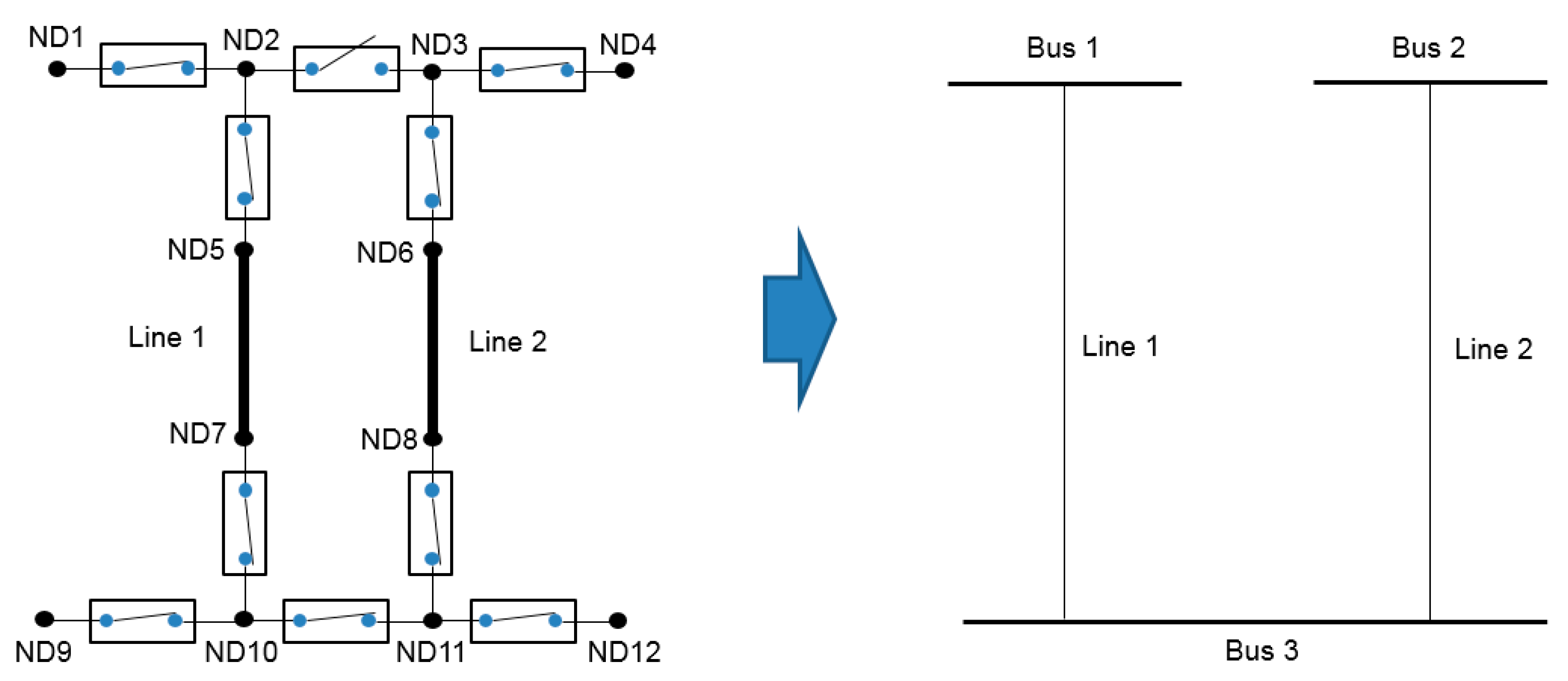


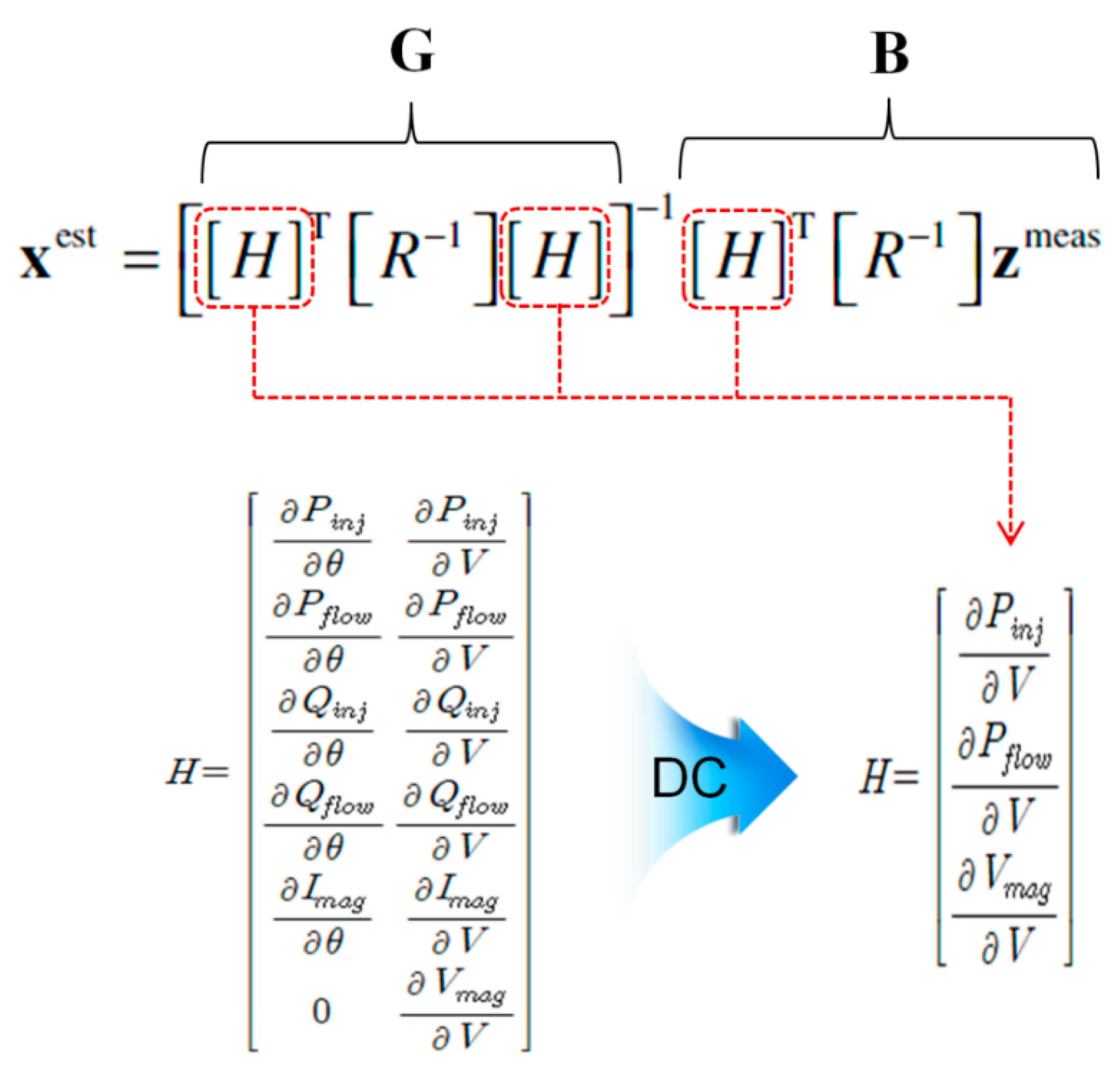
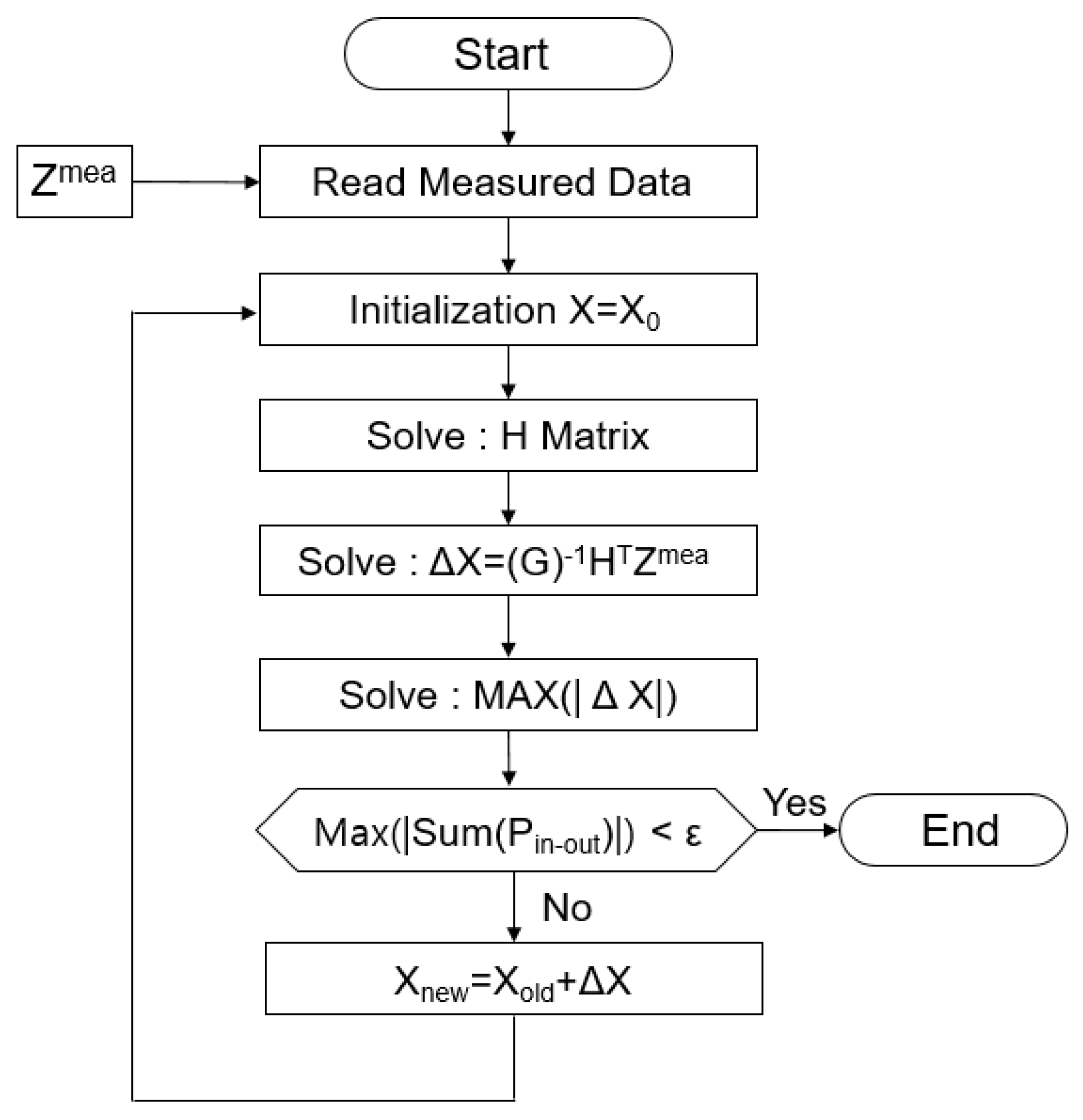


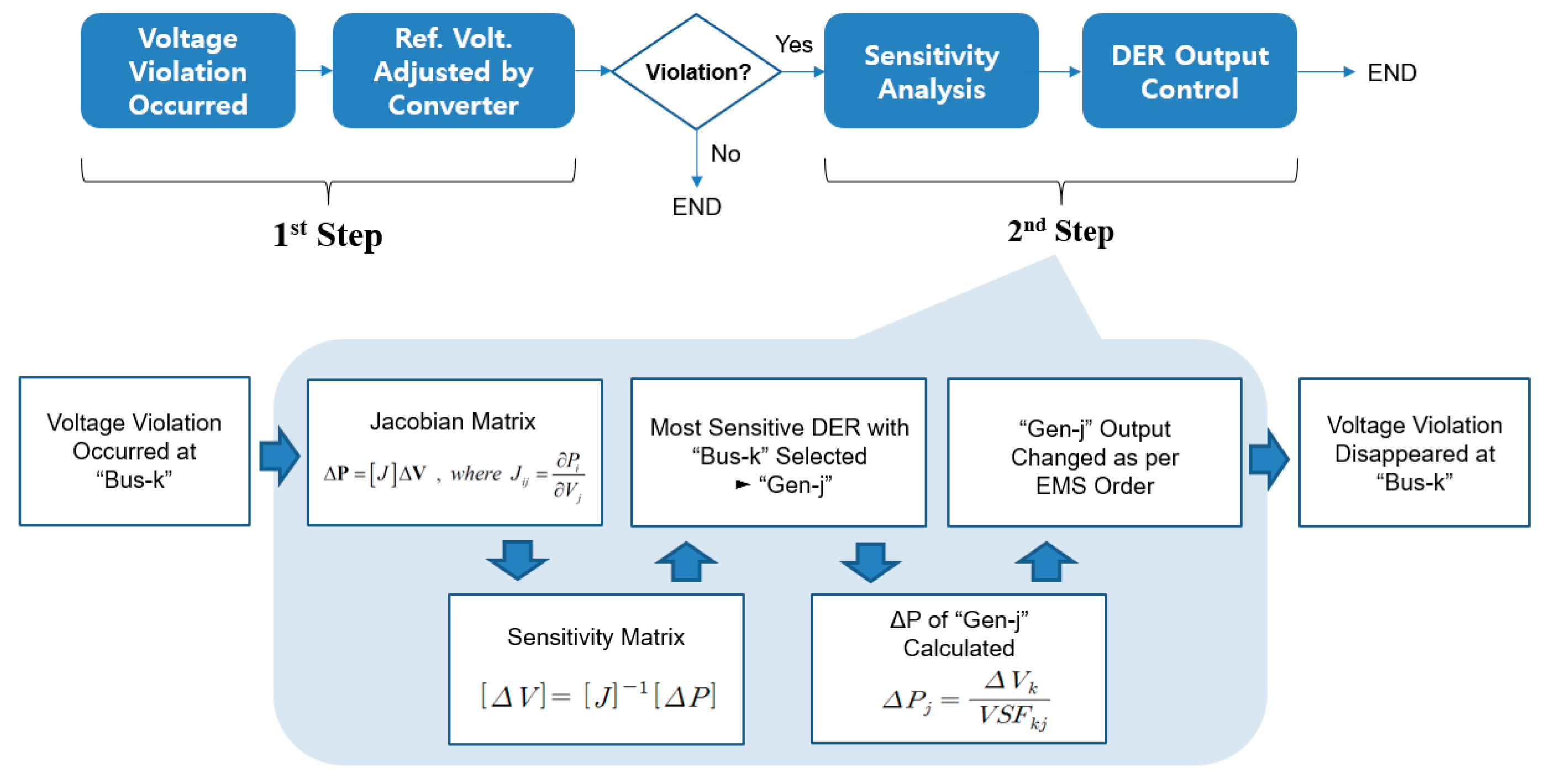
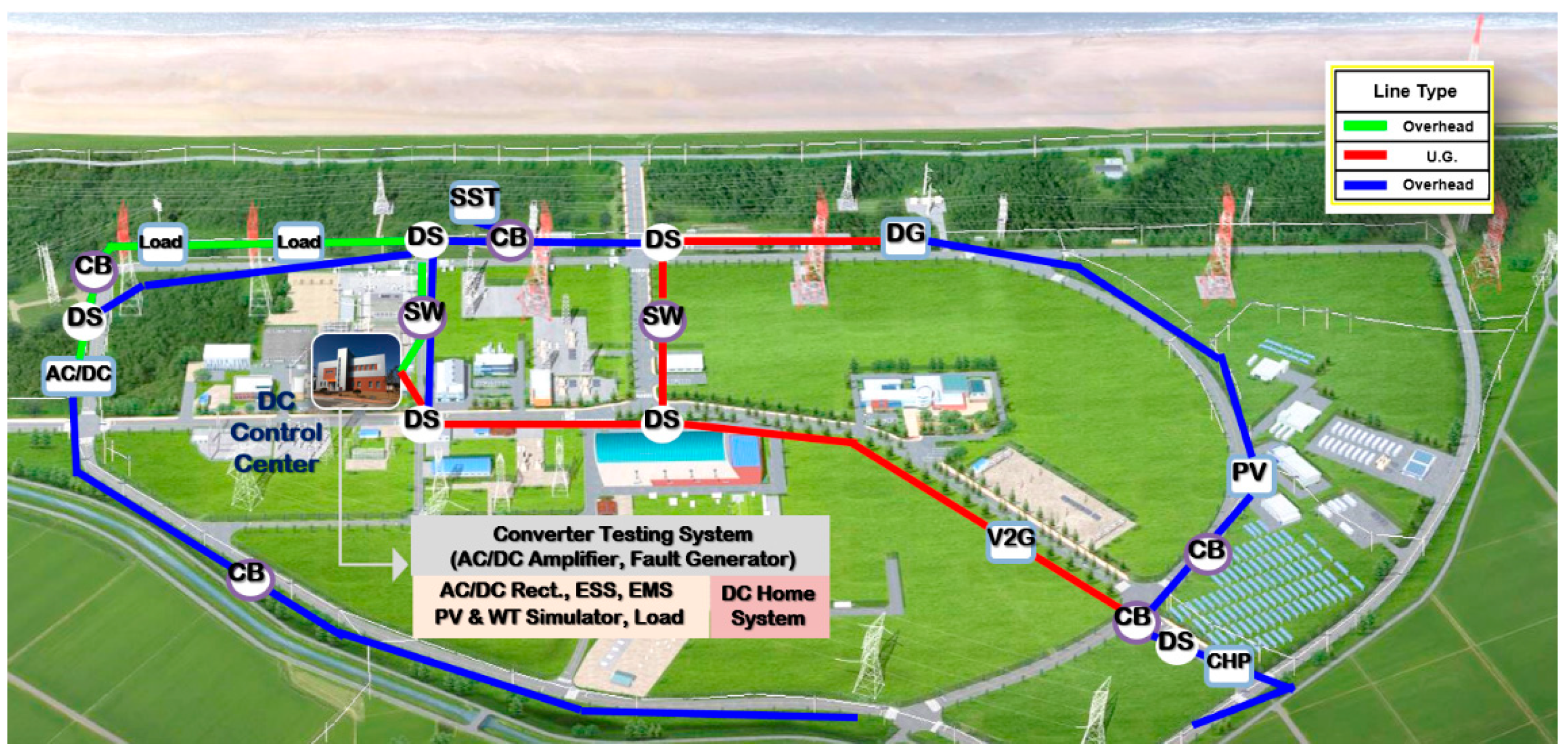
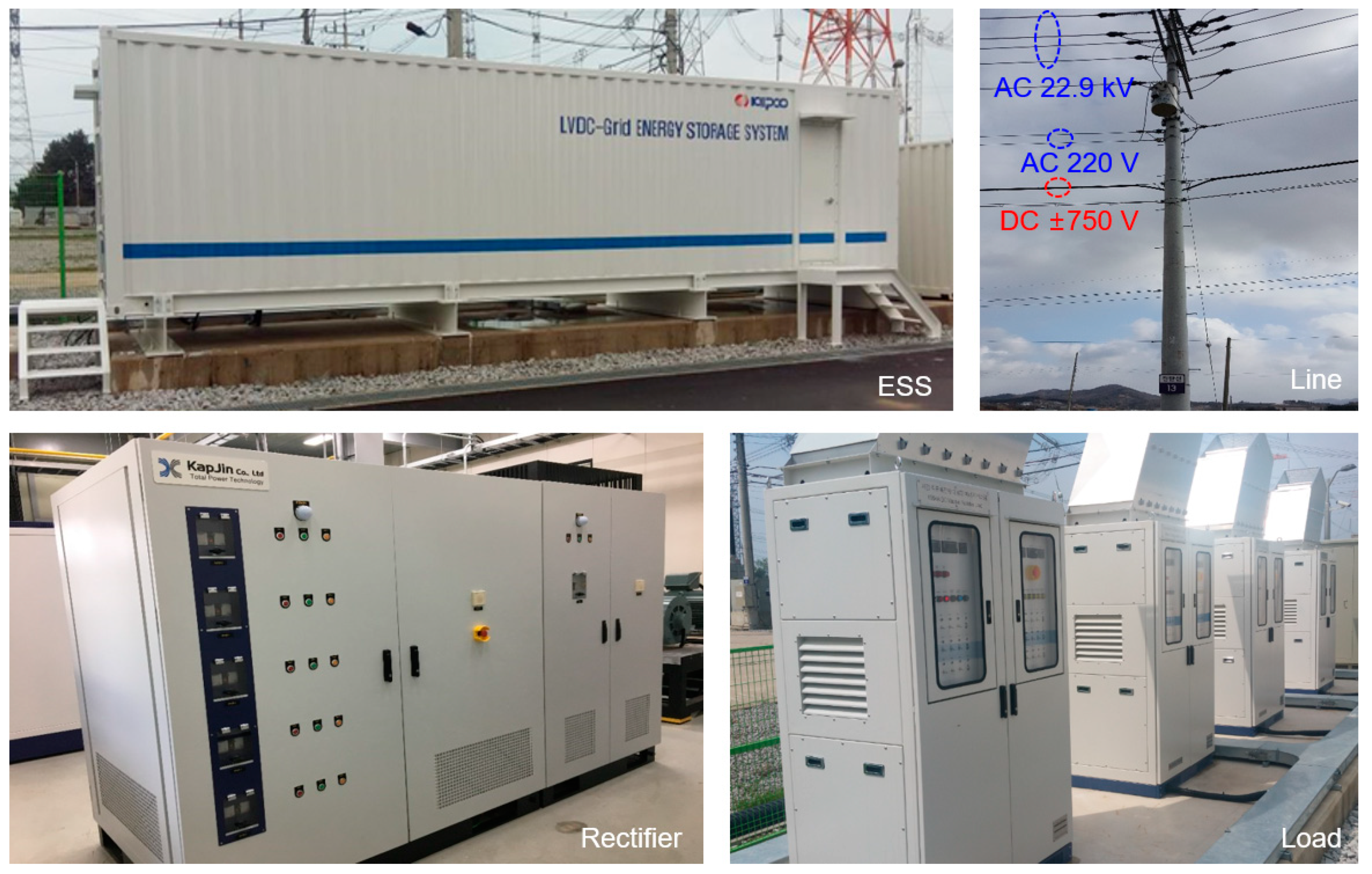
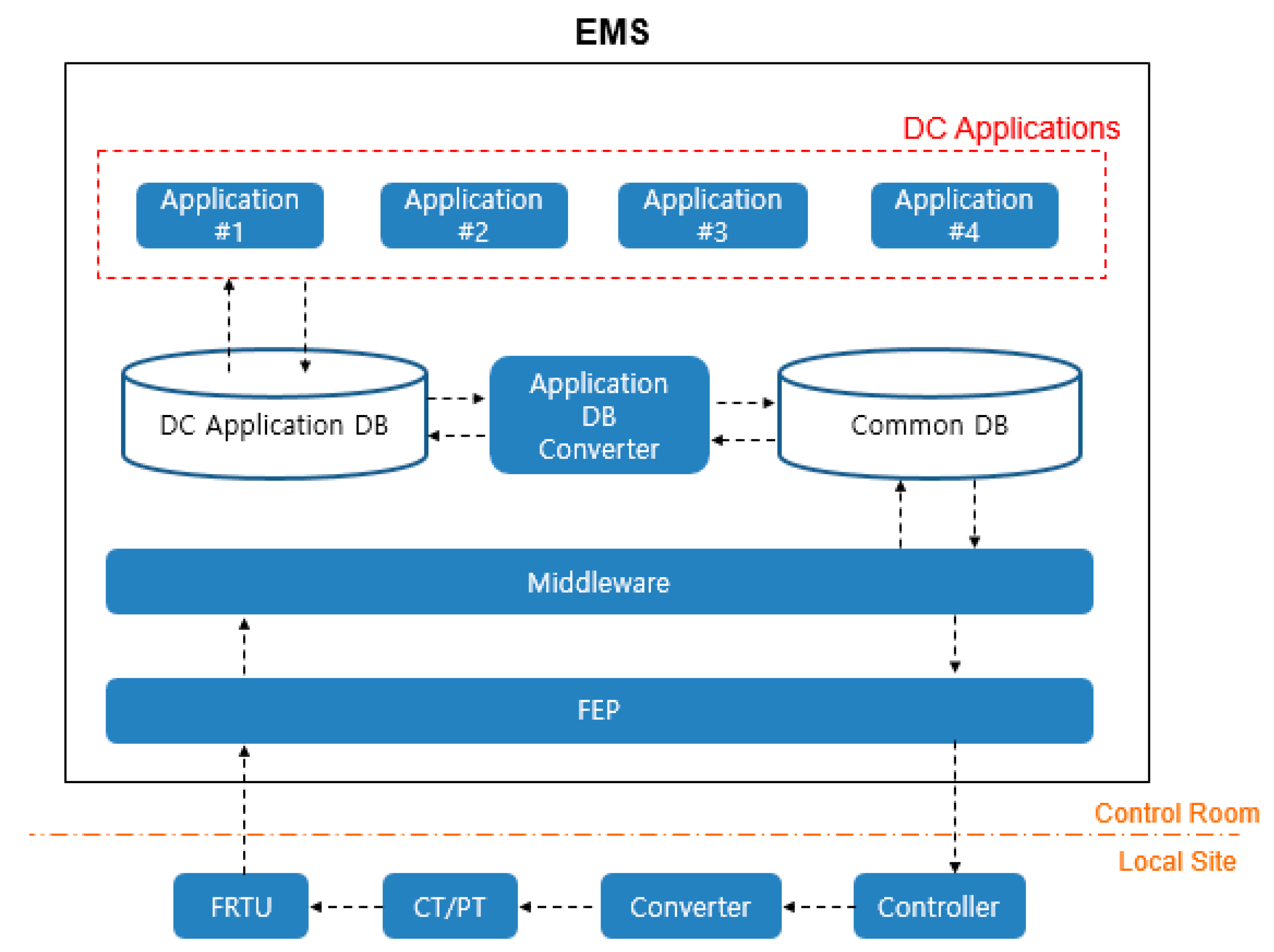
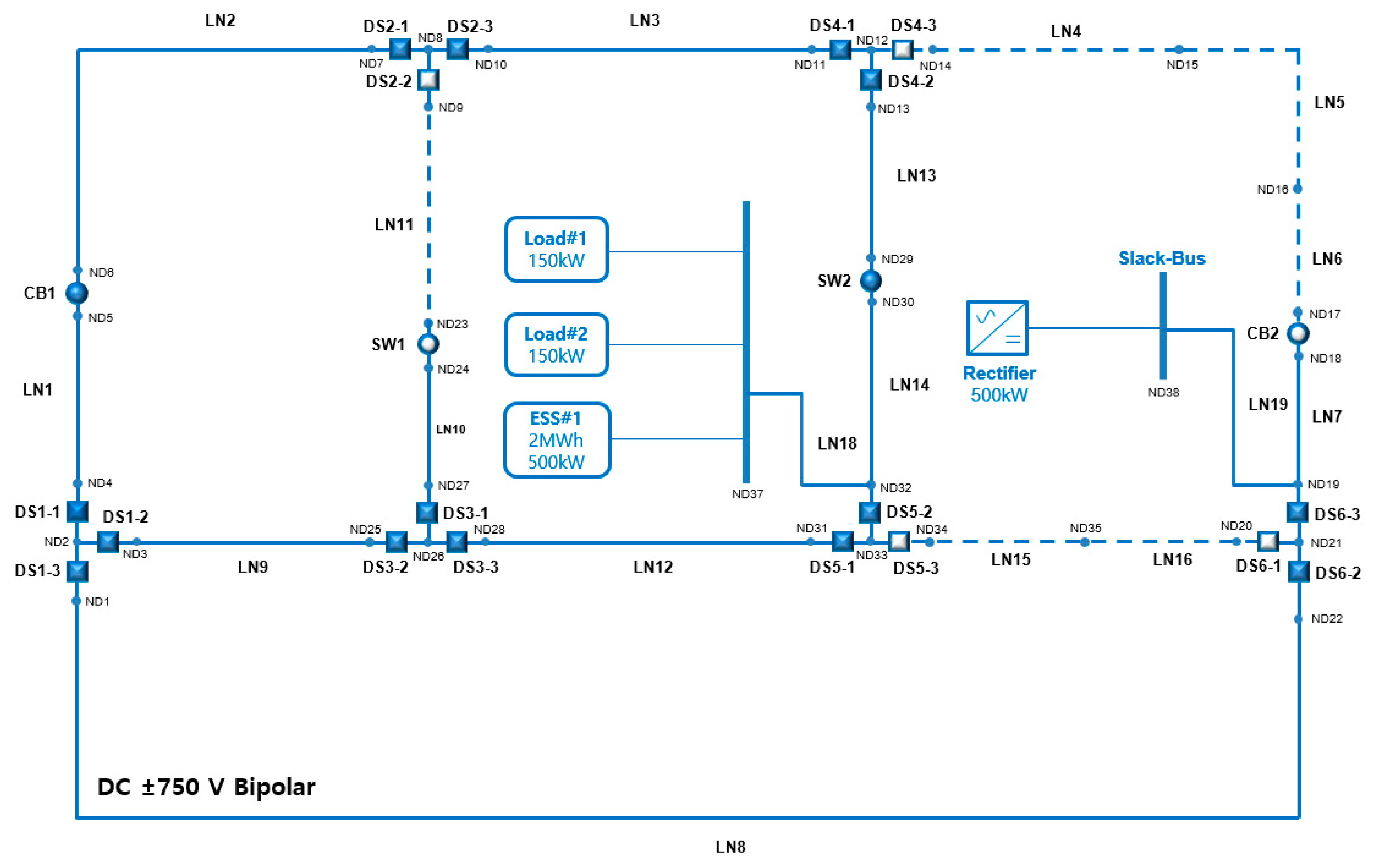
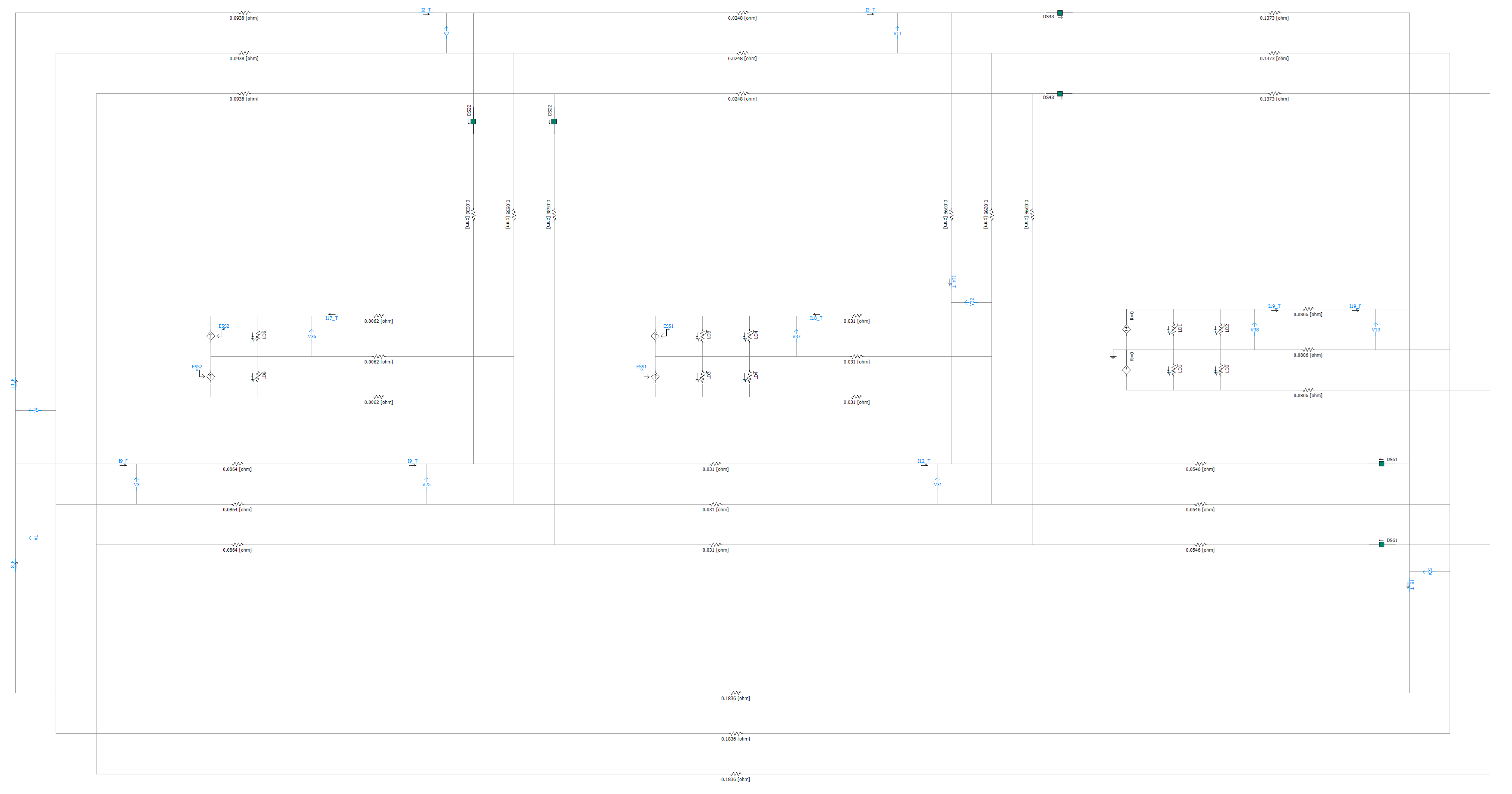

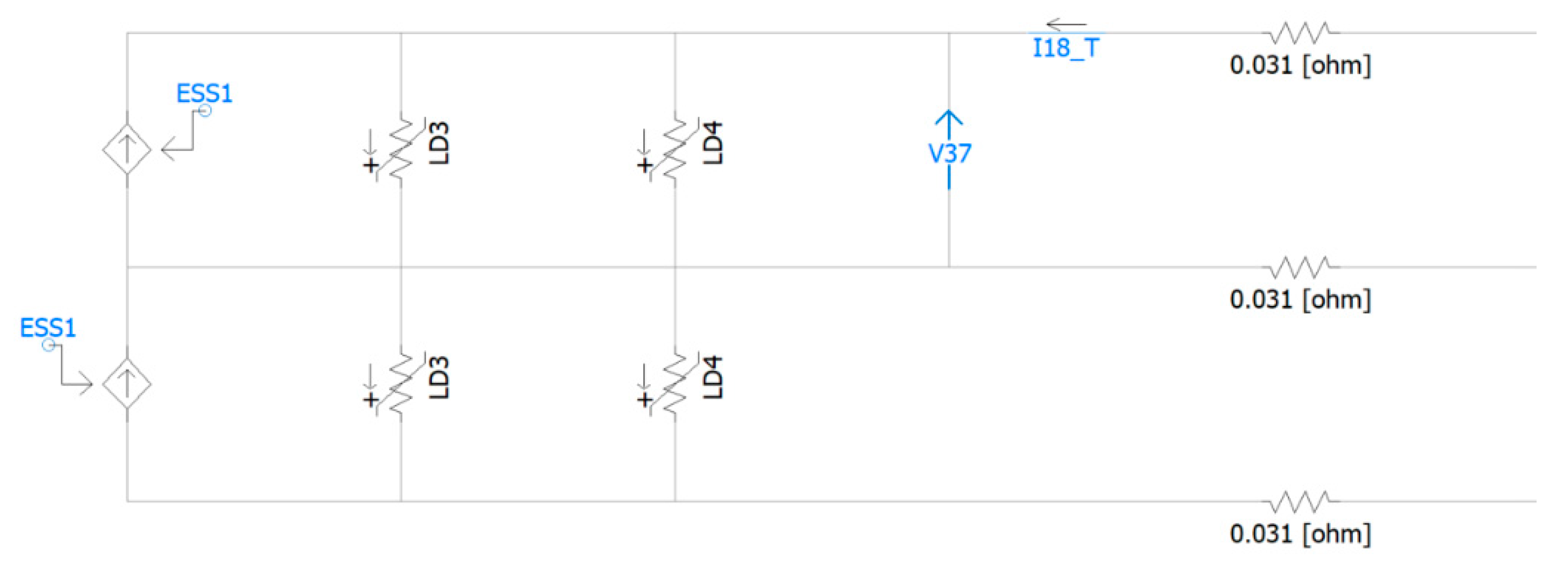
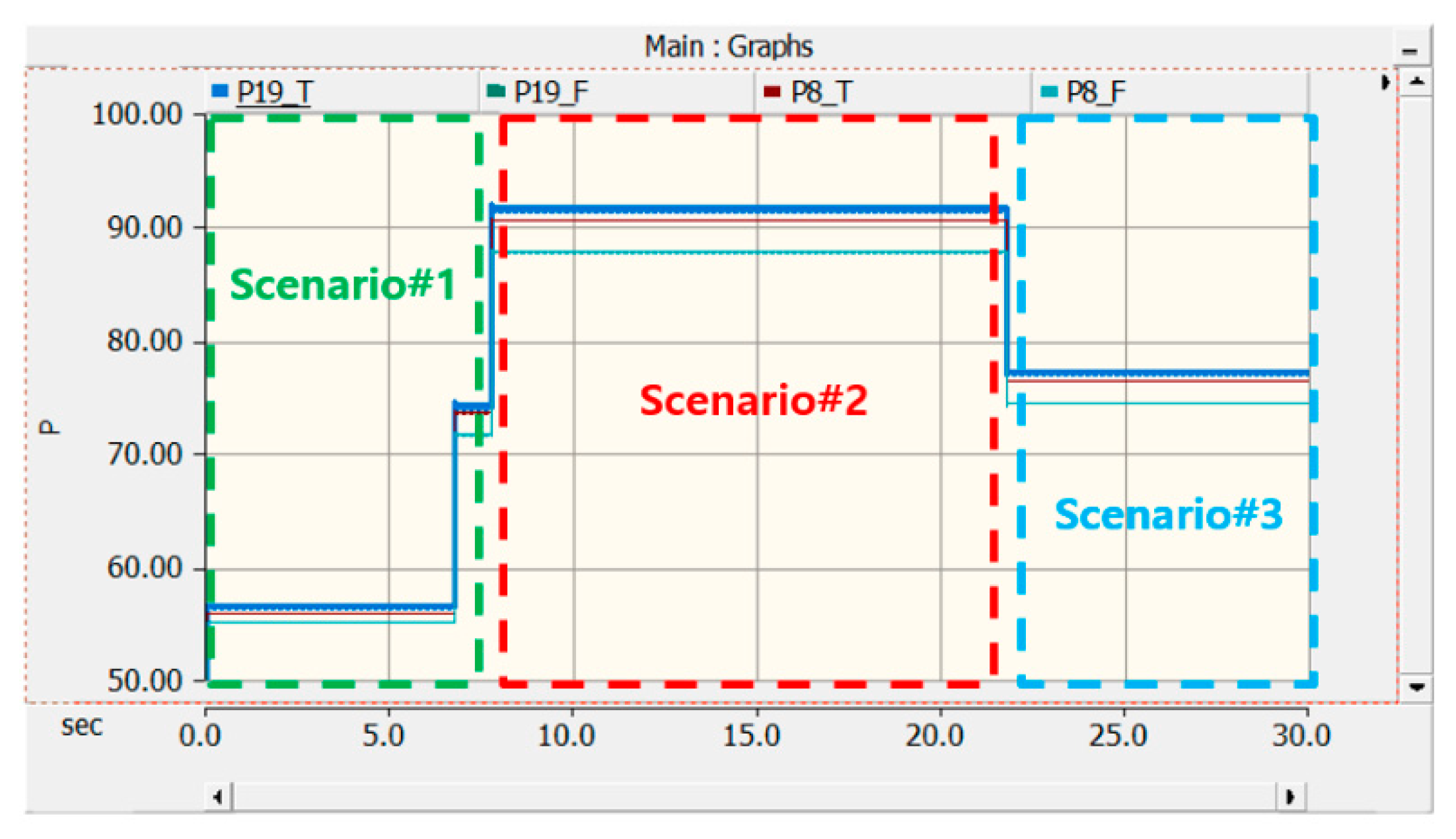
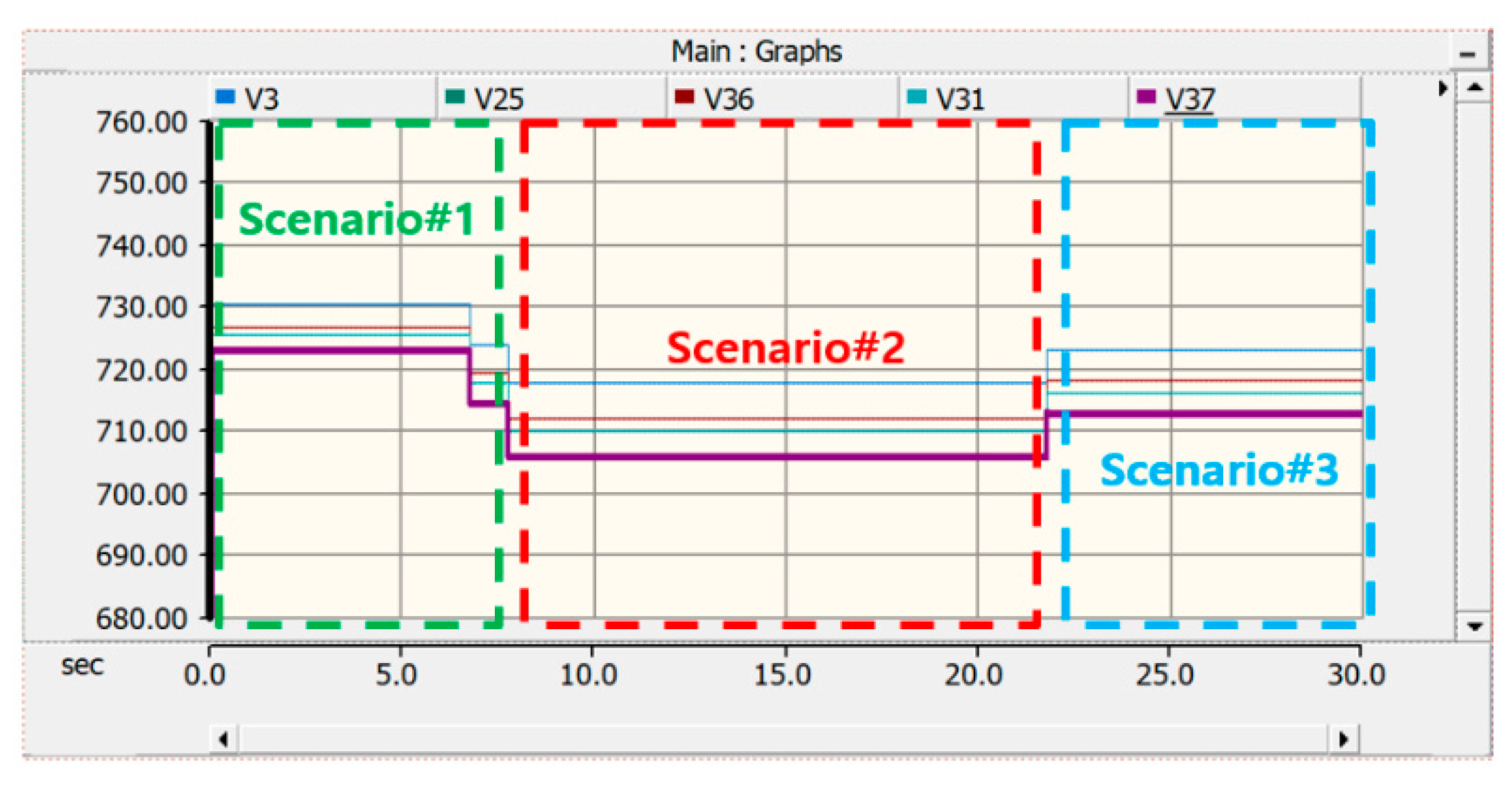
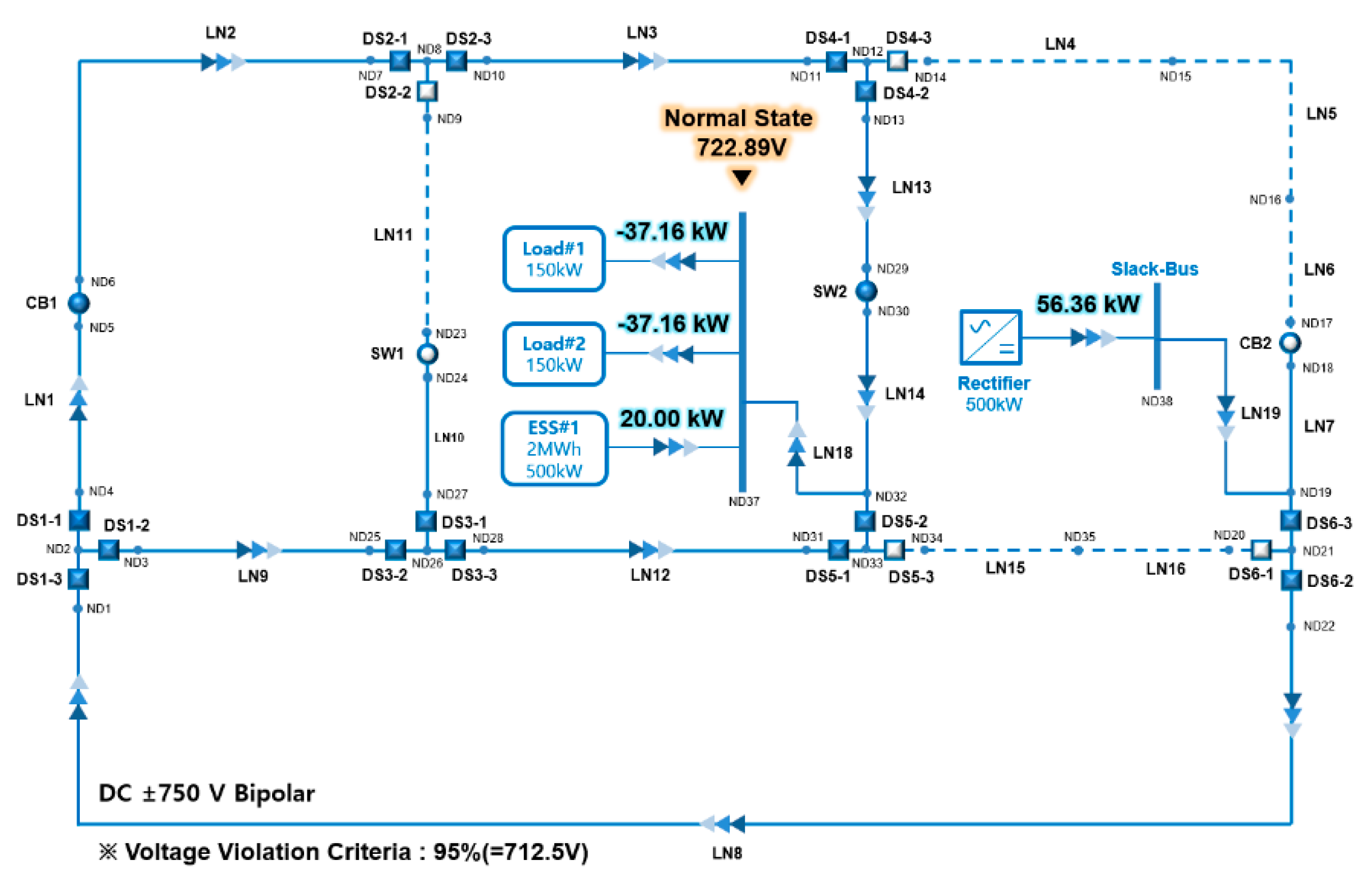
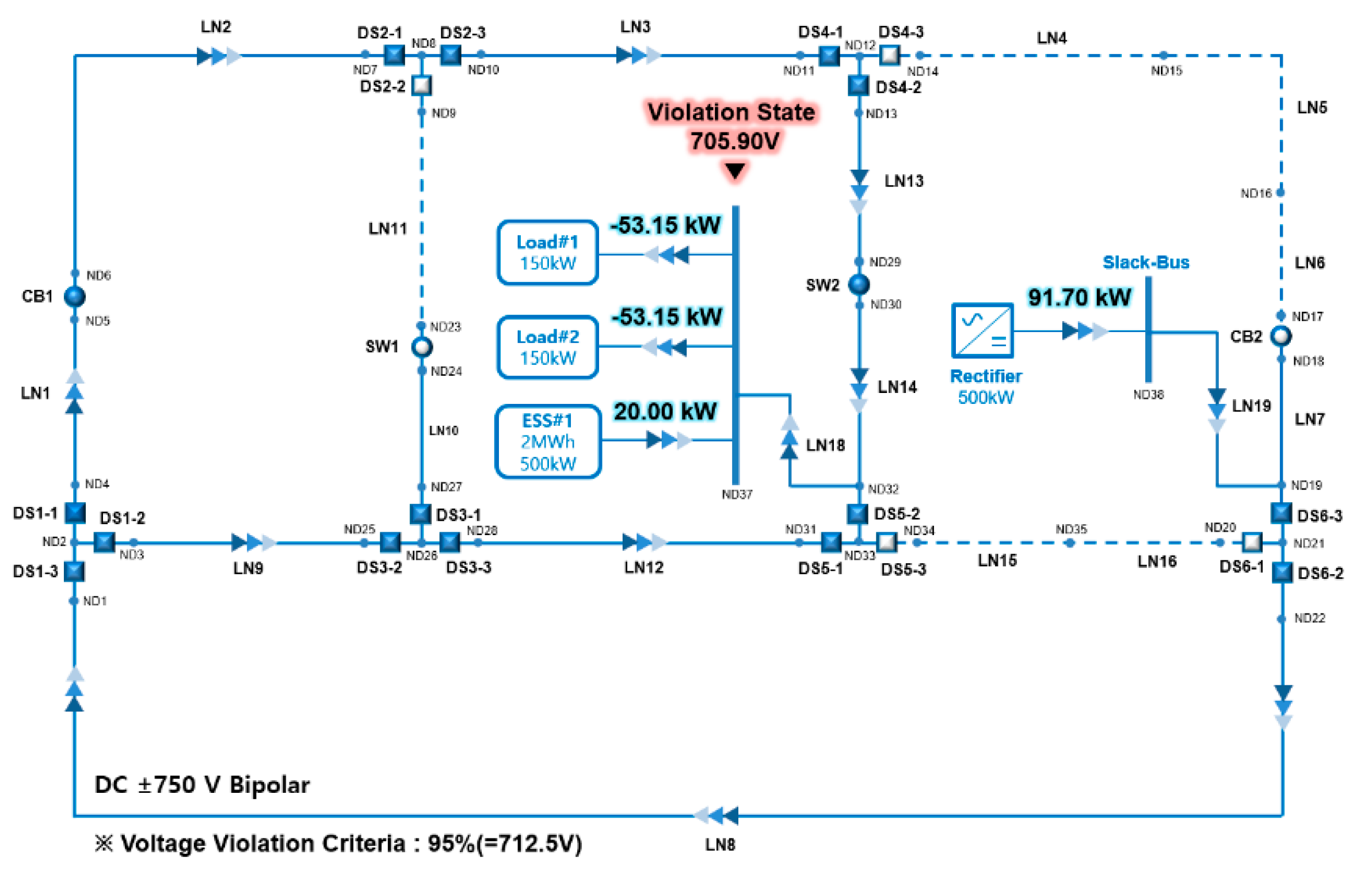
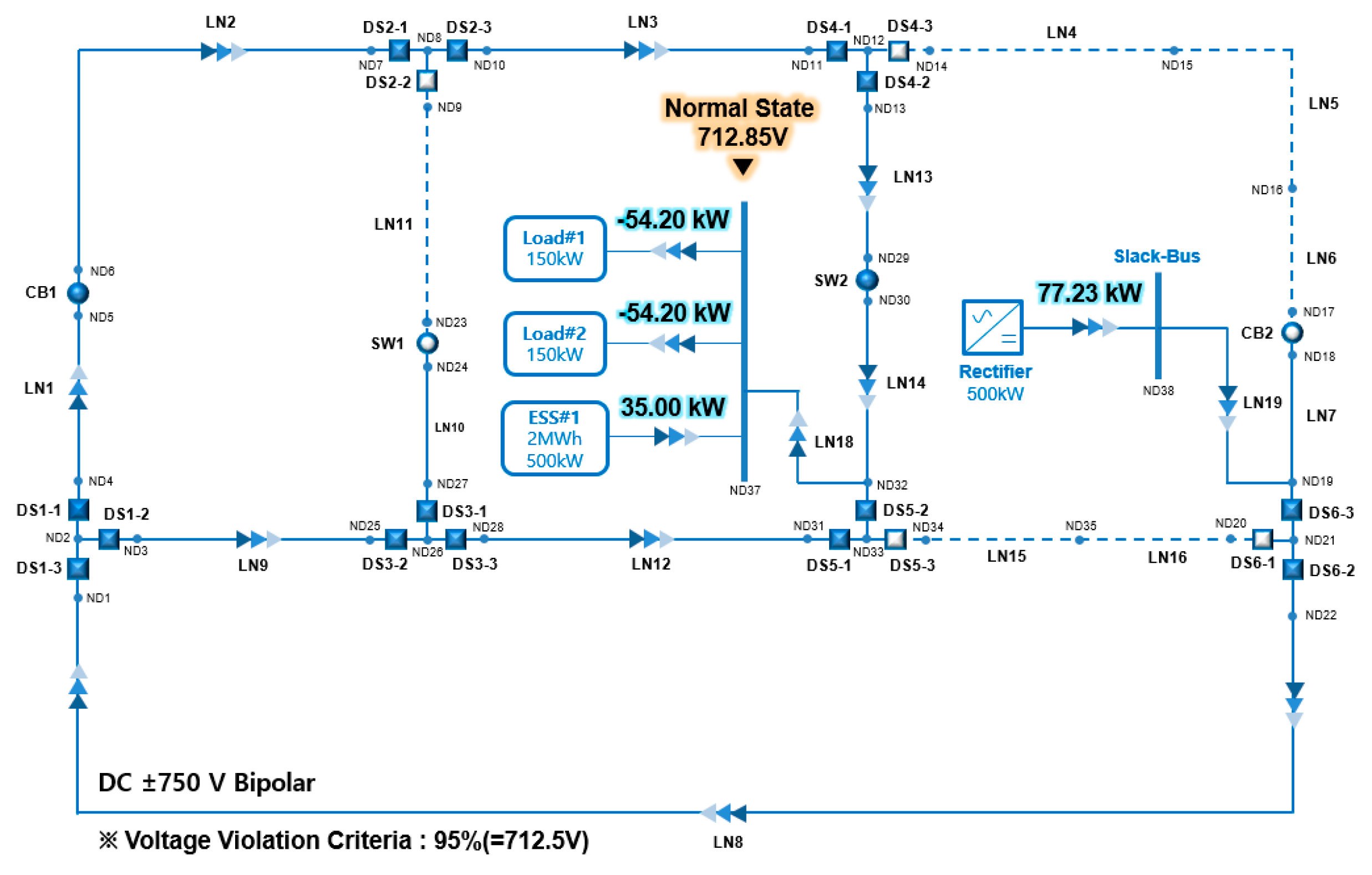
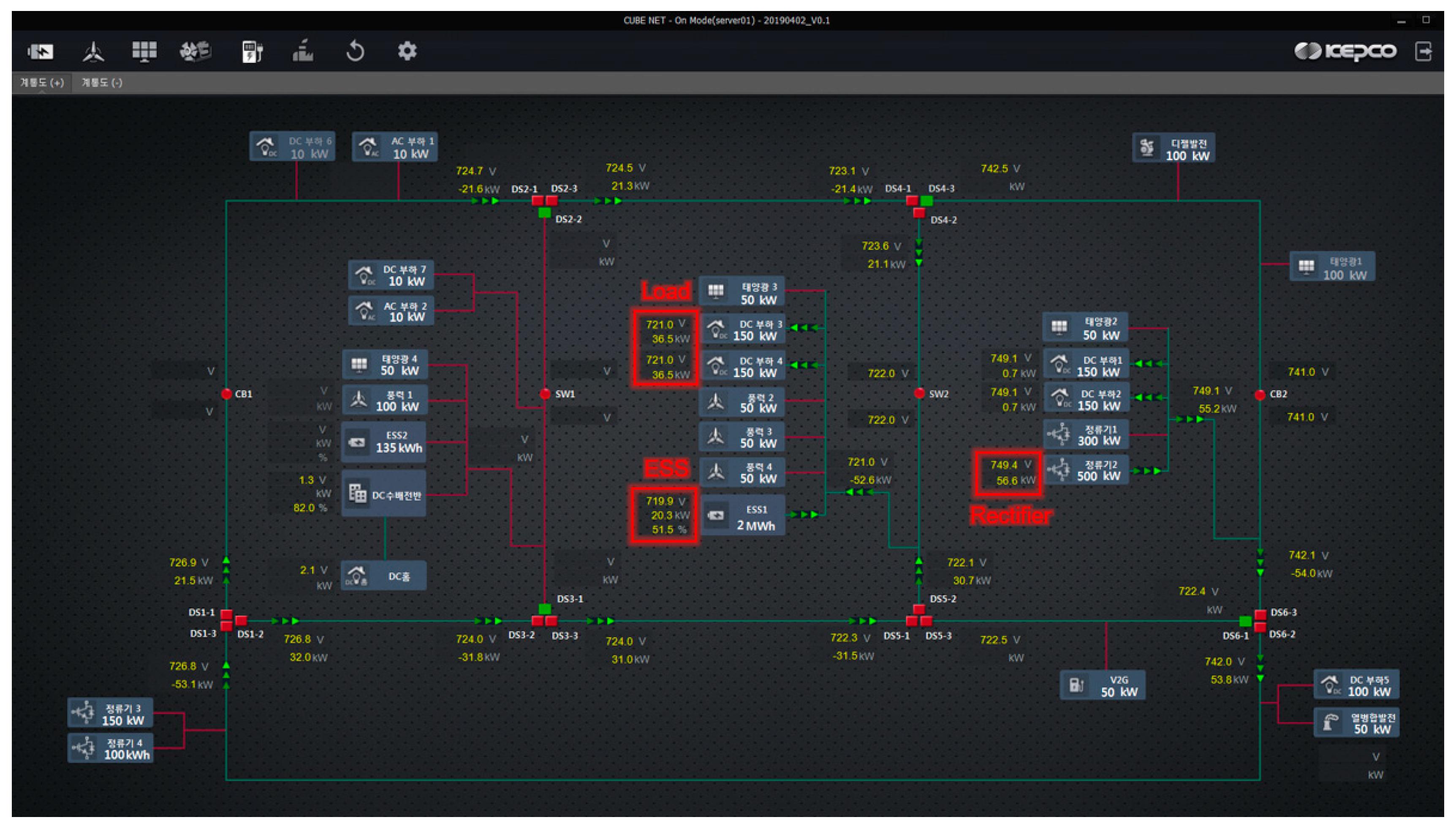

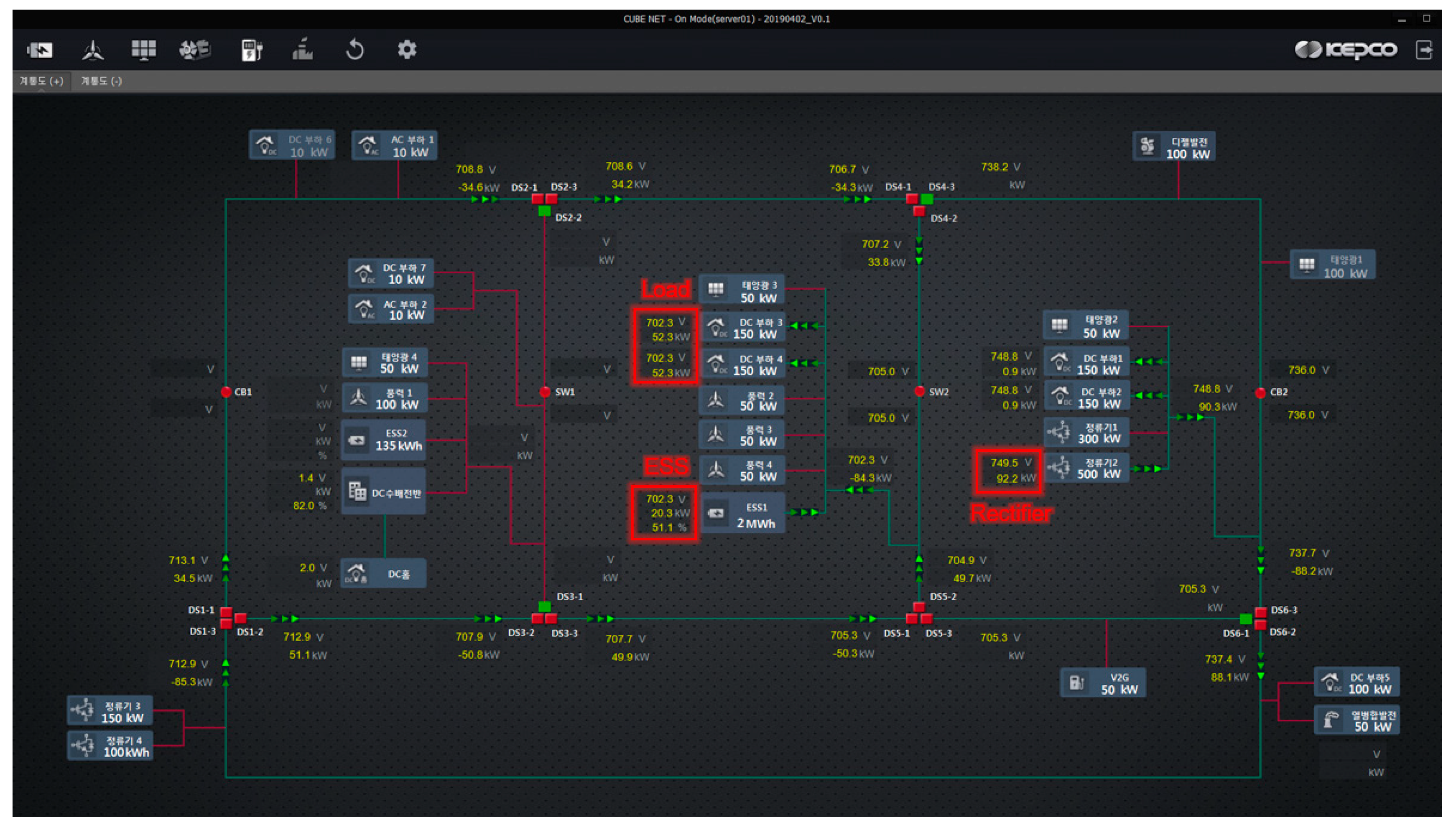

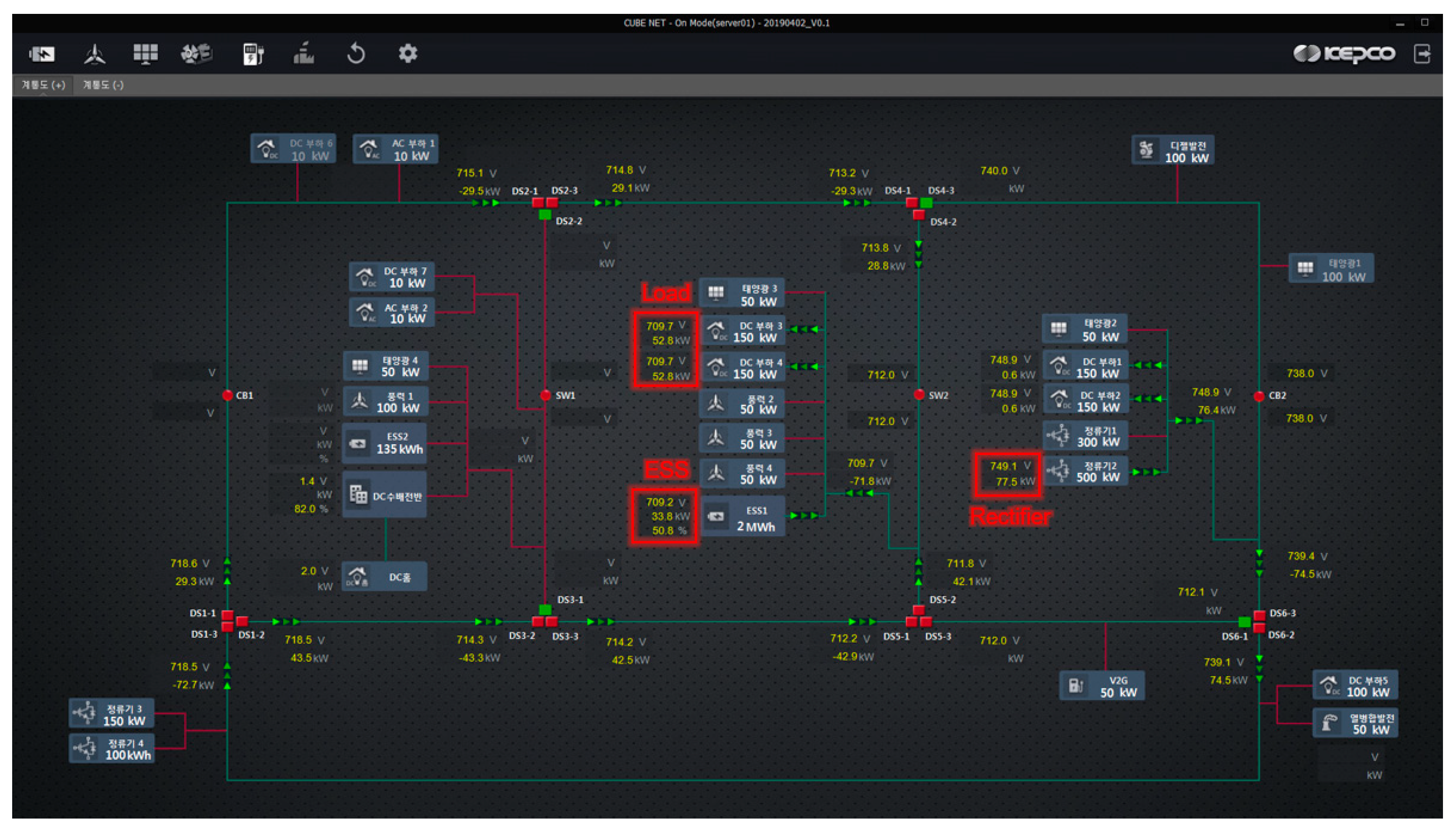
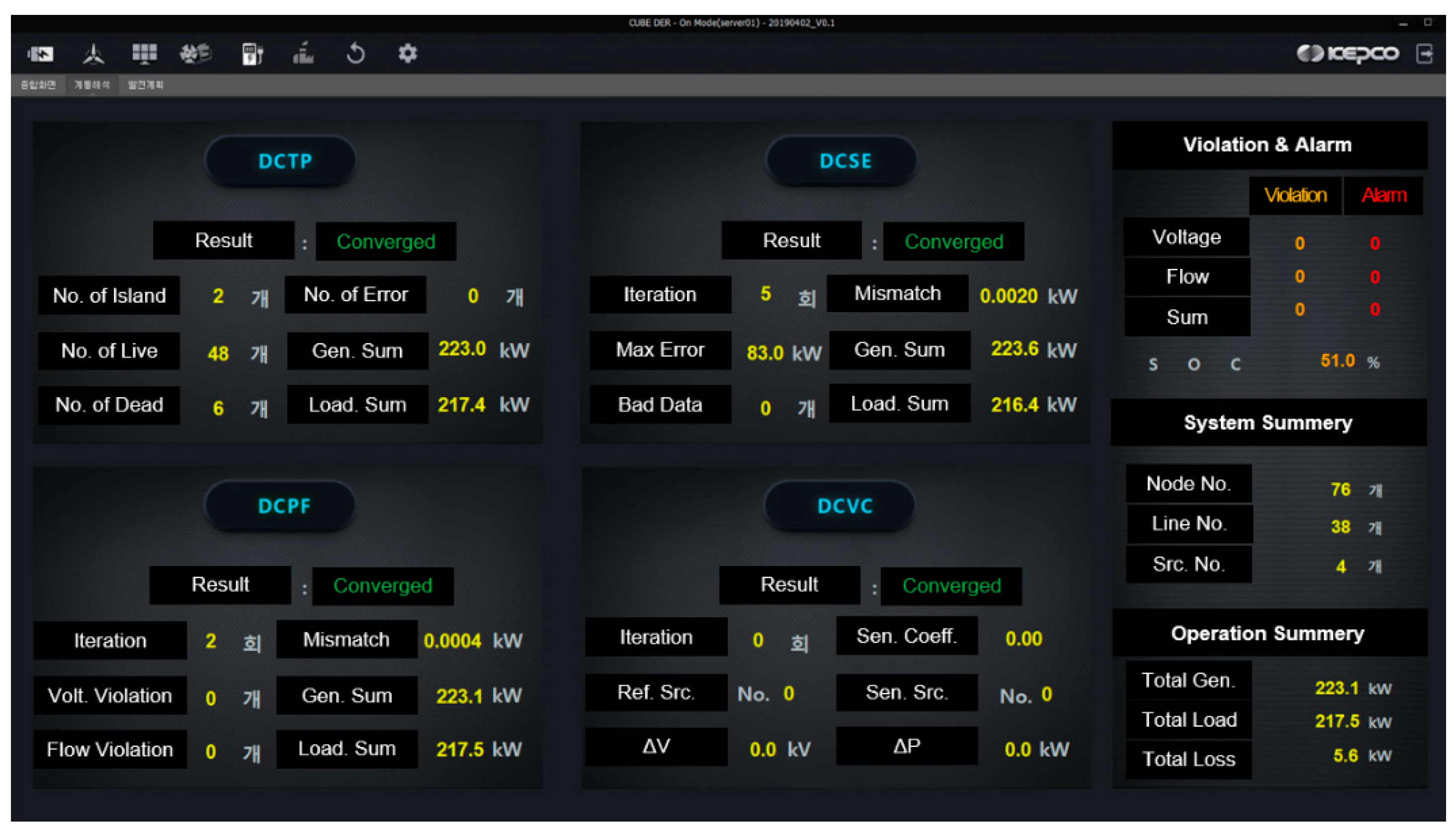
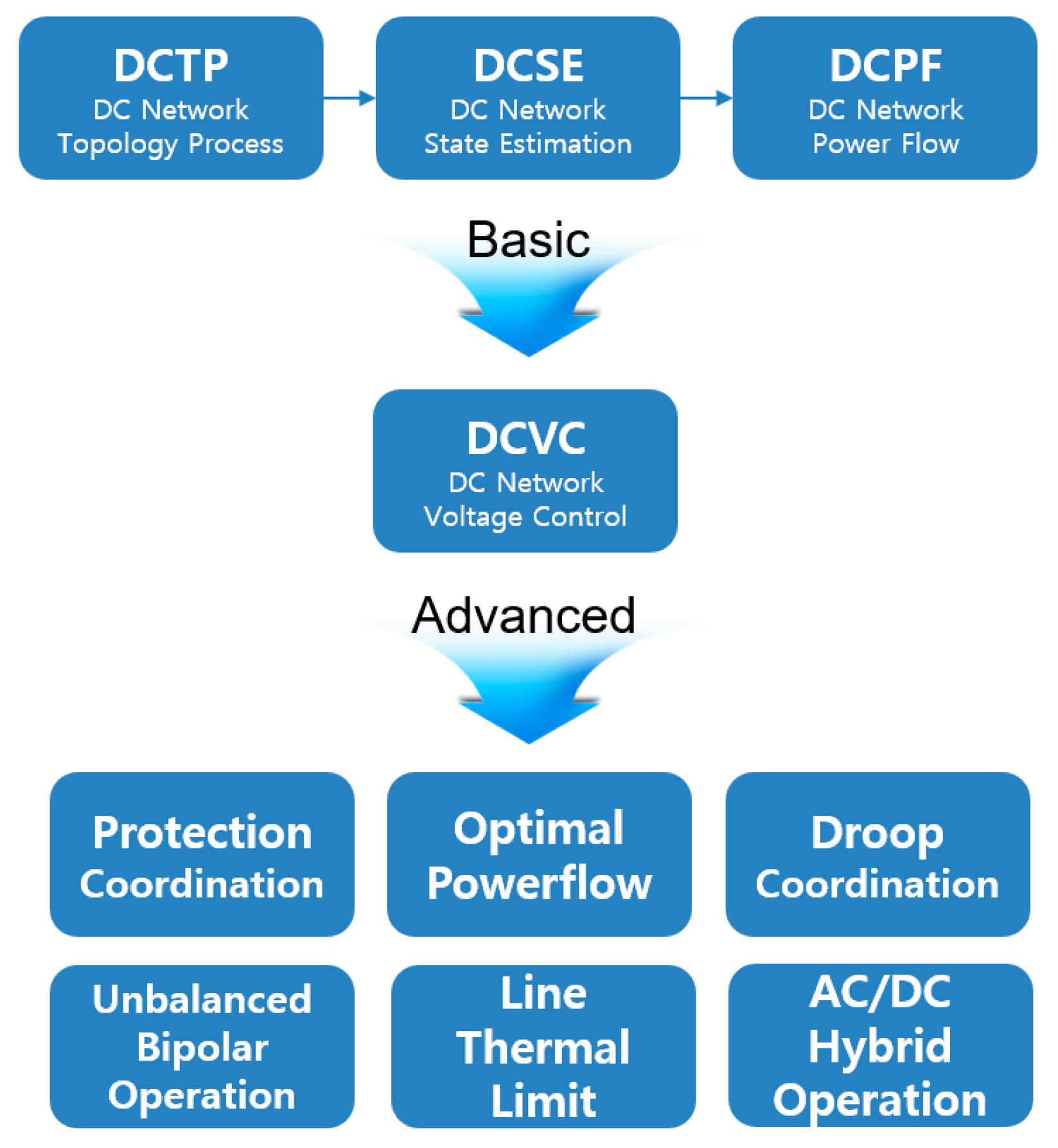
| Category | AC Network | DC Network |
|---|---|---|
| Variable | Frequency, Voltage, Current, Angle | Voltage, Current |
| Line parameter | Resistance, Inductance, Capacitance | resistance |
| Network topology | A, B, C, Neutral | (+), (−), N |
| Power balancing | Frequency | Voltage |
| Demand response | Constant voltage constant frequency (or Droop control) | Constant voltage (or Droop control) |
| grounding | Multi-grounding | Isolated terra |
| Voltage level | Transformer ►Integrated matrix (Per Unit method) | DC/DC converter ►Seperated matrix |
| Voltage control | Capacitor, Over load tap changer, Under load tap changer | Reference voltage control, Power output control |
| Approved voltage | Transmission system: ±5% distribution system: ±10% | ±10% (Converter approved voltage) |
| Algorithm | Main algorithm of state estimation and power flow | |
| Category | State Estimation | Power Flow |
|---|---|---|
| Variable | All Measured Data (Voltage, Power) | V (Generator/Load Bus), P (Slack Bus) |
| Input | All Measured Data (Voltage, Power) | P (Generator/Load Bus), V (Slack Bus) |
| Equation | X=[HTR−1H]−1·[HT][R−1]Zmeas | X = J−1 B |
| Control | Bad Data Process | V (Generator/Load Bus), P (Slack Bus) |
| Convergence | Threshold > Pmismatch | Threshold > ΔX |
| Mismatch | Bus In/Out Mismatch Exist | No Mismatch |
| Node No. | Measured Data (Vdc) | (DCSE) Output Data (Vdc) | (DCPF) Output Data (Vdc) | PSCAD/EMTDC (Vdc) | Measured Data & PSCAD/EMTDC Error (%) | (DCSE) Output Data & PSCAD/EMTDC Error (%) | (DCPF) Output Data & PSCAD/EMTDC Error (%) |
|---|---|---|---|---|---|---|---|
| 1-p | 726.89 | 729.94 | 729.96 | 730.15 | 0.4468 | 0.0283 | 0.0261 |
| 3-p | 727.42 | 729.94 | 729.96 | 730.15 | 0.3735 | 0.0283 | 0.0261 |
| 4-p | 726.99 | 729.94 | 729.96 | 730.15 | 0.4333 | 0.0283 | 0.0261 |
| 7-p | 724.68 | 726.95 | 726.97 | 727.03 | 0.3228 | 0.0111 | 0.0085 |
| 10-p | 724.61 | 726.95 | 726.97 | 727.03 | 0.3329 | 0.0111 | 0.0085 |
| 11-p | 723.32 | 726.16 | 726.18 | 726.21 | 0.3982 | 0.0072 | 0.0046 |
| 13-p | 723.75 | 726.16 | 726.18 | 726.21 | 0.3387 | 0.0072 | 0.0046 |
| 19-p | 742.10 | 743.21 | 743.22 | 743.94 | 0.2471 | 0.0979 | 0.0972 |
| 22-p | 741.90 | 743.21 | 743.22 | 743.94 | 0.2738 | 0.0979 | 0.0972 |
| 25-p | 724.08 | 726.46 | 726.48 | 726.52 | 0.3357 | 0.0086 | 0.0060 |
| 28-p | −727.80 | 726.46 | 726.48 | 726.52 | 0.1761 | 0.0086 | 0.0060 |
| 31-p | 722.47 | 725.21 | 725.23 | 725.22 | 0.3786 | 0.0019 | 0.0009 |
| 32-p | 722.00 | 725.21 | 725.23 | 725.22 | 0.4437 | 0.0019 | 0.0009 |
| 37-p | 721.01 | 722.97 | 722.97 | 722.89 | 0.2598 | 0.0105 | 0.0105 |
| 38-p | 749.04 | 749.04 | 749.04 | 750.00 | 0.1285 | 0.1285 | 0.1285 |
| 1-n | −731.37 | −733.57 | −733.58 | −730.15 | 0.1675 | 0.4680 | 0.4696 |
| 3-n | −731.33 | −733.57 | −733.58 | −730.15 | 0.1613 | 0.4680 | 0.4696 |
| 4-n | −731.56 | −733.57 | −733.58 | −730.15 | 0.1927 | 0.4680 | 0.4696 |
| 7-n | −728.44 | −730.50 | −730.51 | −727.03 | 0.1938 | 0.4768 | 0.4786 |
| 10-n | −728.22 | −730.50 | −730.51 | −727.03 | 0.1637 | 0.4768 | 0.4786 |
| 11-n | −727.58 | −729.68 | −729.70 | −726.21 | 0.1884 | 0.4785 | 0.4803 |
| 13-n | −727.15 | −729.68 | −729.70 | −726.21 | 0.1300 | 0.4785 | 0.4803 |
| 19-n | −746.45 | −747.18 | −747.18 | −743.94 | 0.3372 | 0.4350 | 0.4354 |
| 22-n | −746.57 | −747.18 | −747.18 | −743.94 | 0.3534 | 0.4350 | 0.4354 |
| 25-n | −727.37 | −729.99 | −730.01 | −726.52 | 0.1165 | 0.4779 | 0.4798 |
| 28-n | 723.94 | −729.99 | −730.01 | −726.52 | 0.3549 | 0.4779 | 0.4798 |
| 31-n | −726.43 | −728.71 | −728.72 | −725.22 | 0.1665 | 0.4811 | 0.4831 |
| 32-n | −725.99 | −728.71 | −728.72 | −725.22 | 0.1055 | 0.4811 | 0.4831 |
| 37-n | −723.88 | −726.41 | −726.41 | −722.89 | 0.1371 | 0.4871 | 0.4871 |
| 38-n | −753.15 | −753.15 | −753.15 | −750.00 | 0.4200 | 0.4200 | 0.4200 |
| Average Error (%) | 0.2700 | 0.2506 | 0.2505 | ||||
| Node No. | Measured Data (Vdc) | (DCSE) Output Data (Vdc) | (DCPF) Output Data (Vdc) | PSCAD/EMTDC (Vdc) | Measured Data & PSCAD/EMTDC Error (%) | (DCSE) Output Data & PSCAD/EMTDC Error (%) | (DCPF) Output Data & PSCAD/EMTDC Error (%) |
|---|---|---|---|---|---|---|---|
| 1-p | 713.04 | 717.32 | 717.31 | 717.70 | 0.6495 | 0.0528 | 0.0548 |
| 3-p | 713.53 | 717.32 | 717.31 | 717.70 | 0.5816 | 0.0528 | 0.0548 |
| 4-p | 713.04 | 717.32 | 717.31 | 717.70 | 0.649 | 0.0528 | 0.0548 |
| 7-p | 708.89 | 712.42 | 712.37 | 712.63 | 0.5253 | 0.0301 | 0.0361 |
| 10-p | 708.53 | 712.42 | 712.37 | 712.63 | 0.5757 | 0.0301 | 0.0361 |
| 11-p | 706.72 | 711.12 | 711.07 | 711.29 | 0.6432 | 0.0241 | 0.0311 |
| 13-p | 707.20 | 711.12 | 711.07 | 711.29 | 0.5755 | 0.0241 | 0.0311 |
| 19-p | 737.70 | 739.06 | 739.17 | 740.15 | 0.3314 | 0.1471 | 0.1323 |
| 22-p | 737.34 | 739.06 | 739.17 | 740.15 | 0.3803 | 0.1471 | 0.1323 |
| 25-p | 707.80 | 711.61 | 711.56 | 711.80 | 0.5621 | 0.0268 | 0.0334 |
| 28-p | −711.93 | 711.61 | 711.56 | 711.80 | 0.0185 | 0.0268 | 0.0334 |
| 31-p | 705.17 | 709.56 | 709.50 | 709.69 | 0.6365 | 0.0184 | 0.0266 |
| 32-p | 704.96 | 709.56 | 709.50 | 709.69 | 0.6665 | 0.0184 | 0.0266 |
| 37-p | 702.30 | 705.89 | 705.74 | 705.90 | 0.5105 | 0.0016 | 0.0223 |
| 38-p | 748.77 | 748.60 | 748.77 | 750.00 | 0.1641 | 0.186 | 0.1641 |
| 1-n | −717.53 | −721.46 | −721.31 | 717.70 | 0.0231 | 0.5233 | 0.5022 |
| 3-n | −717.52 | −721.46 | −721.31 | 717.70 | 0.0250 | 0.5233 | 0.5022 |
| 4-n | −717.63 | −721.46 | −721.31 | 717.70 | 0.0092 | 0.5233 | 0.5022 |
| 7-n | −712.81 | −716.55 | −716.38 | 712.63 | 0.0248 | 0.5498 | 0.5264 |
| 10-n | −712.49 | −716.55 | −716.38 | 712.63 | 0.0197 | 0.5498 | 0.5264 |
| 11-n | −711.01 | −715.25 | −715.08 | 711.29 | 0.0390 | 0.5567 | 0.5328 |
| 13-n | −710.87 | −715.25 | −715.08 | 711.29 | 0.0597 | 0.5567 | 0.5328 |
| 19-n | −742.12 | −743.21 | −743.12 | 740.15 | 0.2657 | 0.4129 | 0.4015 |
| 22-n | −742.05 | −743.21 | −743.12 | 740.15 | 0.2572 | 0.4129 | 0.4015 |
| 25-n | −711.44 | −715.74 | −715.57 | 711.80 | 0.0508 | 0.5537 | 0.5300 |
| 28-n | 707.62 | −715.74 | −715.57 | 711.80 | 0.5875 | 0.5537 | 0.5300 |
| 31-n | −709.34 | −713.69 | −713.52 | 709.69 | 0.0487 | 0.5637 | 0.5391 |
| 32-n | −709.09 | −713.69 | −713.52 | 709.69 | 0.0841 | 0.5637 | 0.5391 |
| 37-n | −705.52 | −710.02 | −709.80 | 705.90 | 0.0537 | 0.5834 | 0.5530 |
| 38-n | −752.70 | −752.75 | −752.70 | 750.00 | 0.3599 | 0.3672 | 0.3599 |
| Average Error (%) | 0.3109 | 0.2873 | 0.2776 | ||||
| Node No. | Measured Data (Vdc) | (DCSE) Output Data (Vdc) | (DCPF) Output Data (Vdc) | PSCAD/EMTDC (Vdc) | Measured Data & PSCAD/EMTDC Error (%) | (DCSE) Output Data & PSCAD/EMTDC Error (%) | (DCPF) Output Data & PSCAD/EMTDC Error (%) |
|---|---|---|---|---|---|---|---|
| 1-p | 718.60 | 722.19 | 722.22 | 722.79 | 0.5792 | 0.0831 | 0.0787 |
| 3-p | 719.06 | 722.19 | 722.22 | 722.79 | 0.5162 | 0.0831 | 0.0787 |
| 4-p | 718.61 | 722.19 | 722.22 | 722.79 | 0.5778 | 0.0831 | 0.0787 |
| 7-p | 715.17 | 718.00 | 718.04 | 718.57 | 0.4736 | 0.0791 | 0.0740 |
| 10-p | 714.79 | 718.00 | 718.04 | 718.57 | 0.5263 | 0.0791 | 0.0740 |
| 11-p | 713.34 | 716.89 | 716.93 | 717.40 | 0.5662 | 0.0705 | 0.0652 |
| 13-p | 713.79 | 716.89 | 716.93 | 717.40 | 0.5027 | 0.0705 | 0.0652 |
| 19-p | 739.38 | 740.75 | 740.76 | 741.70 | 0.3125 | 0.1282 | 0.1269 |
| 22-p | 739.28 | 740.75 | 740.76 | 741.70 | 0.3269 | 0.1282 | 0.1269 |
| 25-p | 714.30 | 717.31 | 717.35 | 717.83 | 0.4913 | 0.0720 | 0.0667 |
| 28-p | −718.17 | 717.31 | 717.35 | 717.83 | 0.0480 | 0.0720 | 0.0667 |
| 31-p | 712.11 | 715.56 | 715.60 | 716.04 | 0.5485 | 0.0665 | 0.0609 |
| 32-p | 711.84 | 715.56 | 715.60 | 716.04 | 0.5859 | 0.0665 | 0.0609 |
| 37-p | 709.79 | 712.43 | 712.43 | 712.85 | 0.4288 | 0.0590 | 0.0590 |
| 38-p | 748.90 | 748.90 | 748.90 | 750.00 | 0.1471 | 0.1471 | 0.1471 |
| 1-n | −722.95 | −726.09 | −726.09 | 722.79 | 0.0217 | 0.4564 | 0.4569 |
| 3-n | −723.17 | −726.09 | −726.09 | 722.79 | 0.0529 | 0.4564 | 0.4569 |
| 4-n | −722.91 | −726.09 | −726.09 | 722.79 | 0.0163 | 0.4564 | 0.4569 |
| 7-n | −719.04 | −721.88 | −721.89 | 718.57 | 0.0653 | 0.4611 | 0.4617 |
| 10-n | −718.67 | −721.88 | −721.89 | 718.57 | 0.0143 | 0.4611 | 0.4617 |
| 11-n | −717.35 | −720.77 | −720.78 | 717.40 | 0.0070 | 0.4700 | 0.4705 |
| 13-n | −717.24 | −720.77 | −720.78 | 717.40 | 0.0227 | 0.4700 | 0.4705 |
| 19-n | −743.81 | −744.73 | −744.73 | 741.70 | 0.2842 | 0.4079 | 0.4080 |
| 22-n | −743.62 | −744.73 | −744.73 | 741.70 | 0.2582 | 0.4079 | 0.4080 |
| 25-n | −717.79 | −721.19 | −721.20 | 717.83 | 0.0063 | 0.4684 | 0.4690 |
| 28-n | 714.17 | −721.19 | −721.20 | 717.83 | 0.5101 | 0.4684 | 0.4690 |
| 31-n | −716.19 | −719.44 | −719.44 | 716.04 | 0.0214 | 0.4742 | 0.4748 |
| 32-n | −715.69 | −719.44 | −719.44 | 716.04 | 0.0491 | 0.4742 | 0.4748 |
| 37-n | −712.76 | −716.29 | −716.29 | 712.85 | 0.0124 | 0.4824 | 0.4824 |
| 38-n | −752.91 | −752.91 | −752.91 | 750.00 | 0.3875 | 0.3875 | 0.3875 |
| Average Error (%) | 0.2794 | 0.2696 | 0.2679 | ||||
| Equipment | Measured Data (kW) | (DCSE) Output Data (kW) | (DCPF) Output Data (kW) | PSCAD/EMTDC (kW) | Measured Data & PSCAD/EMTDC Error (%) | (DCSE) Output Data & PSCAD/EMTDC Error (%) | (DCPF) Output Data & PSCAD/EMTDC Error (%) |
|---|---|---|---|---|---|---|---|
| Rectifier (Pos.) | 54.20 | 54.13 | 54.09 | 56.36 | 3.8325 | 3.9540 | 4.0355 |
| ESS (Pos.) | 20.30 | 20.40 | 20.29 | 20.00 | 1.5110 | 1.9875 | 1.4700 |
| Rectifier (Neg.) | 56.00 | 55.82 | 55.79 | 56.36 | 0.6388 | 0.9514 | 1.0092 |
| ESS (Neg.) | 20.66 | 20.72 | 20.65 | 20.00 | 3.2910 | 3.5960 | 3.2355 |
| Load#1 (Pos.) | −36.50 | −36.32 | −36.51 | −37.16 | 1.7874 | 2.2489 | 1.7530 |
| Load#2 (Pos.) | −36.50 | −36.32 | −36.51 | −37.16 | 1.7874 | 2.2489 | 1.7530 |
| Load#1 (Neg.) | −37.39 | −37.28 | −37.41 | −37.16 | 0.6254 | 0.3280 | 0.6773 |
| Load#2 (Neg.) | −37.39 | −37.28 | −37.41 | −37.16 | 0.6254 | 0.3280 | 0.6773 |
| Average Error (%) | 1.7624 | 1.9554 | 1.8264 | ||||
| Equipment | Measured Data (kW) | (DCSE) Output Data (kW) | (DCPF) Output Data (kW) | PSCAD/EMTDC (kW) | Measured Data & PSCAD/EMTDC Error (%) | (DCSE) Output Data & PSCAD/EMTDC Error (%) | (DCPF] Output Data & PSCAD/EMTDC Error (%) |
|---|---|---|---|---|---|---|---|
| Rectifier (Pos.) | 91.30 | 89.31 | 89.17 | 91.70 | 0.4362 | 2.6108 | 2.7622 |
| ESS (Pos.) | 19.49 | 19.50 | 19.28 | 20.00 | 2.5730 | 2.5030 | 3.6040 |
| Rectifier (Neg.) | 89.60 | 89.50 | 89.44 | 91.70 | 2.2901 | 2.3960 | 2.4609 |
| ESS (Neg.) | 20.40 | 20.62 | 20.52 | 20.00 | 2.0075 | 3.0770 | 2.5865 |
| Load#1 (Pos.) | −51.88 | −51.84 | −52.43 | −53.15 | 2.3893 | 2.4595 | 1.3582 |
| Load#2 (Pos.) | −51.88 | −51.84 | −52.43 | −53.15 | 2.3893 | 2.4595 | 1.3582 |
| Load#1 (Neg.) | −53.07 | −52.51 | −52.76 | −53.15 | 0.1550 | 1.2019 | 0.7317 |
| Load#2 (Neg.) | −53.07 | −52.51 | −52.76 | −53.15 | 0.1550 | 1.2019 | 0.7317 |
| Average Error (%) | 1.5494 | 2.2387 | 1.9492 | ||||
| Equipment | Measured Data (kW) | (DCSE) Output Data (kW) | (DCPF) Output Data (kW) | PSCAD/EMTDC (kW) | Measured Data & PSCAD/EMTDC Error (%) | (DCSE) Output Data & PSCAD/EMTDC Error (%) | (DCPF) Output Data & PSCAD/EMTDC Error (%) |
|---|---|---|---|---|---|---|---|
| Rectifier (Pos.) | 76.60 | 75.70 | 75.61 | 77.23 | 0.8157 | 1.9766 | 2.0939 |
| ESS (Pos.) | 33.49 | 33.43 | 33.21 | 35.00 | 4.3197 | 4.4900 | 5.1214 |
| Rectifier (Neg.) | 76.40 | 76.42 | 76.41 | 77.23 | 1.0747 | 1.0436 | 1.0562 |
| ESS (Neg.) | 34.96 | 35.08 | 35.05 | 35.00 | 0.1011 | 0.2206 | 0.1520 |
| Load#1 (Pos.) | −52.63 | −52.73 | −53.08 | −54.20 | 2.8899 | 2.7172 | 2.0740 |
| Load#2 (Pos.) | −52.63 | −52.73 | −53.08 | −54.20 | 2.8899 | 2.7172 | 2.0740 |
| Load#1 (Neg.) | −54.07 | −53.89 | −53.93 | −54.20 | 0.2463 | 0.5677 | 0.4996 |
| Load#2 (Neg.) | −54.07 | −53.89 | −53.93 | −54.20 | 0.2463 | 0.5677 | 0.4996 |
| Average Error (%) | 1.5730 | 1.7876 | 1.6963 | ||||
© 2020 by the authors. Licensee MDPI, Basel, Switzerland. This article is an open access article distributed under the terms and conditions of the Creative Commons Attribution (CC BY) license (http://creativecommons.org/licenses/by/4.0/).
Share and Cite
Kim, J.; Kim, H.; Cho, J.; Cho, Y.; Cho, Y.; Kim, S. Demonstration Study of Voltage Control of DC Grid Using Energy Management System Based DC Applications. Energies 2020, 13, 4551. https://doi.org/10.3390/en13174551
Kim J, Kim H, Cho J, Cho Y, Cho Y, Kim S. Demonstration Study of Voltage Control of DC Grid Using Energy Management System Based DC Applications. Energies. 2020; 13(17):4551. https://doi.org/10.3390/en13174551
Chicago/Turabian StyleKim, Juyong, Hongjoo Kim, Jintae Cho, Youngpyo Cho, Yoonsung Cho, and Sukcheol Kim. 2020. "Demonstration Study of Voltage Control of DC Grid Using Energy Management System Based DC Applications" Energies 13, no. 17: 4551. https://doi.org/10.3390/en13174551
APA StyleKim, J., Kim, H., Cho, J., Cho, Y., Cho, Y., & Kim, S. (2020). Demonstration Study of Voltage Control of DC Grid Using Energy Management System Based DC Applications. Energies, 13(17), 4551. https://doi.org/10.3390/en13174551





